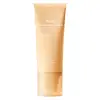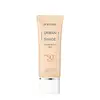What's inside
What's inside
 Key Ingredients
Key Ingredients

 Benefits
Benefits

 Concerns
Concerns

 Ingredients Side-by-side
Ingredients Side-by-side

Water
Skin ConditioningDibutyl Adipate
EmollientPropanediol
SolventCI 77891
Cosmetic ColorantBis-Ethylhexyloxyphenol Methoxyphenyl Triazine
Skin ConditioningDiethylamino Hydroxybenzoyl Hexyl Benzoate
UV FilterEthylhexyl Triazone
UV AbsorberPolysilicone-15
UV FilterNiacinamide
SmoothingCoco-Caprylate/Caprate
EmollientDiisopropyl Sebacate
EmollientPolymethylsilsesquioxane
Butylene Glycol
Humectant1,2-Hexanediol
Skin ConditioningGlycerin
HumectantMethylene Bis-Benzotriazolyl Tetramethylbutylphenol
UV FilterPentylene Glycol
Skin ConditioningIsododecane
EmollientOctyldodecanol
EmollientPotassium Cetyl Phosphate
EmulsifyingBehenyl Alcohol
EmollientPolyacrylate Crosspolymer-6
Emulsion StabilisingPolyglyceryl-3 Methylglucose Distearate
EmulsifyingPoly C10-30 Alkyl Acrylate
Emulsion StabilisingTromethamine
BufferingPolyglyceryl-4 Isostearate
EmulsifyingCI 77492
Cosmetic ColorantCarbomer
Emulsion StabilisingDecyl Glucoside
CleansingIsopropyl Titanium Triisostearate
EmollientAluminum Hydroxide
EmollientAcrylates/C10-30 Alkyl Acrylate Crosspolymer
Emulsion StabilisingMica
Cosmetic ColorantPolyester-1
Sodium Stearoyl Glutamate
CleansingEthylhexylglycerin
Skin ConditioningCI 77491
Cosmetic ColorantAdenosine
Skin ConditioningCI 77499
Cosmetic ColorantGlutathione
Silica Dimethyl Silylate
EmollientXanthan Gum
EmulsifyingTocopherol
AntioxidantAllantoin
Skin ConditioningMalus Domestica Fruit Cell Culture Extract
Skin ConditioningDipropylene Glycol
HumectantBeta-Glucan
Skin ConditioningHydrogenated Lecithin
EmulsifyingCholesterol
EmollientChitosan
Ascorbic Acid
Antioxidant3-O-Ethyl Ascorbic Acid
Skin ConditioningAscorbyl Glucoside
AntioxidantCeramide NP
Skin ConditioningWater, Dibutyl Adipate, Propanediol, CI 77891, Bis-Ethylhexyloxyphenol Methoxyphenyl Triazine, Diethylamino Hydroxybenzoyl Hexyl Benzoate, Ethylhexyl Triazone, Polysilicone-15, Niacinamide, Coco-Caprylate/Caprate, Diisopropyl Sebacate, Polymethylsilsesquioxane, Butylene Glycol, 1,2-Hexanediol, Glycerin, Methylene Bis-Benzotriazolyl Tetramethylbutylphenol, Pentylene Glycol, Isododecane, Octyldodecanol, Potassium Cetyl Phosphate, Behenyl Alcohol, Polyacrylate Crosspolymer-6, Polyglyceryl-3 Methylglucose Distearate, Poly C10-30 Alkyl Acrylate, Tromethamine, Polyglyceryl-4 Isostearate, CI 77492, Carbomer, Decyl Glucoside, Isopropyl Titanium Triisostearate, Aluminum Hydroxide, Acrylates/C10-30 Alkyl Acrylate Crosspolymer, Mica, Polyester-1, Sodium Stearoyl Glutamate, Ethylhexylglycerin, CI 77491, Adenosine, CI 77499, Glutathione, Silica Dimethyl Silylate, Xanthan Gum, Tocopherol, Allantoin, Malus Domestica Fruit Cell Culture Extract, Dipropylene Glycol, Beta-Glucan, Hydrogenated Lecithin, Cholesterol, Chitosan, Ascorbic Acid, 3-O-Ethyl Ascorbic Acid, Ascorbyl Glucoside, Ceramide NP
Water
Skin ConditioningTitanium Dioxide
Cosmetic ColorantPhenyl Trimethicone
Skin ConditioningButylene Glycol
HumectantButyloctyl Salicylate
Skin ConditioningCyclopentasiloxane
EmollientGlycerin
HumectantIsododecane
EmollientPolyglyceryl-4 Diisostearate/Polyhydroxystearate/Sebacate
EmulsifyingButylene Glycol Dicaprylate/Dicaprate
EmollientNiacinamide
SmoothingDimethicone
EmollientPolymethyl Methacrylate
Polyglyceryl-3 Polyricinoleate
EmulsifyingPolymethylsilsesquioxane
Sodium Chloride
MaskingCI 77492
Cosmetic ColorantDisteardimonium Hectorite
StabilisingTrimethylsiloxysilicate
EmollientDimethicone/Vinyl Dimethicone Crosspolymer
Skin ConditioningSorbitan Isostearate
EmulsifyingAluminum Hydroxide
EmollientSorbitan Sesquioleate
EmulsifyingSynthetic Beeswax
Emulsion StabilisingMica
Cosmetic ColorantPropanediol
SolventPortulaca Oleracea Extract
Skin ConditioningStearic Acid
CleansingPanthenol
Skin ConditioningDisiloxane
Skin ConditioningTriethoxycaprylylsilane
Sodium Benzoate
MaskingCI 77491
Cosmetic ColorantTrimethylsiloxysilicate/Dimethiconol Crosspolymer
Propylene Carbonate
SolventPotassium Sorbate
PreservativeSilica
AbrasiveBetula Platyphylla Japonica Juice
Skin ConditioningPolyhydroxystearic Acid
EmulsifyingArtemisia Vulgaris Oil
PerfumingDisodium EDTA
CI 77499
Cosmetic ColorantAdenosine
Skin ConditioningDisodium Stearoyl Glutamate
CleansingEthylhexyl Palmitate
EmollientIsopropyl Myristate
EmollientIsostearic Acid
CleansingLecithin
EmollientHyaluronic Acid
HumectantHydrolyzed Hyaluronic Acid
HumectantSodium Hyaluronate
Humectant1,2-Hexanediol
Skin ConditioningAdansonia Digitata Seed Extract
Skin ConditioningEquisetum Arvense Extract
AstringentOlea Europaea Leaf Extract
PerfumingVaccinium Macrocarpon Fruit Extract
AstringentFructan
Skin ConditioningOpuntia Ficus-Indica Extract
Skin ConditioningWater, Titanium Dioxide, Phenyl Trimethicone, Butylene Glycol, Butyloctyl Salicylate, Cyclopentasiloxane, Glycerin, Isododecane, Polyglyceryl-4 Diisostearate/Polyhydroxystearate/Sebacate, Butylene Glycol Dicaprylate/Dicaprate, Niacinamide, Dimethicone, Polymethyl Methacrylate, Polyglyceryl-3 Polyricinoleate, Polymethylsilsesquioxane, Sodium Chloride, CI 77492, Disteardimonium Hectorite, Trimethylsiloxysilicate, Dimethicone/Vinyl Dimethicone Crosspolymer, Sorbitan Isostearate, Aluminum Hydroxide, Sorbitan Sesquioleate, Synthetic Beeswax, Mica, Propanediol, Portulaca Oleracea Extract, Stearic Acid, Panthenol, Disiloxane, Triethoxycaprylylsilane, Sodium Benzoate, CI 77491, Trimethylsiloxysilicate/Dimethiconol Crosspolymer, Propylene Carbonate, Potassium Sorbate, Silica, Betula Platyphylla Japonica Juice, Polyhydroxystearic Acid, Artemisia Vulgaris Oil, Disodium EDTA, CI 77499, Adenosine, Disodium Stearoyl Glutamate, Ethylhexyl Palmitate, Isopropyl Myristate, Isostearic Acid, Lecithin, Hyaluronic Acid, Hydrolyzed Hyaluronic Acid, Sodium Hyaluronate, 1,2-Hexanediol, Adansonia Digitata Seed Extract, Equisetum Arvense Extract, Olea Europaea Leaf Extract, Vaccinium Macrocarpon Fruit Extract, Fructan, Opuntia Ficus-Indica Extract
 Reviews
Reviews

Ingredients Explained
These ingredients are found in both products.
Ingredients higher up in an ingredient list are typically present in a larger amount.
1,2-Hexanediol is a synthetic liquid and another multi-functional powerhouse.
It is a:
- Humectant, drawing moisture into the skin
- Emollient, helping to soften skin
- Solvent, dispersing and stabilizing formulas
- Preservative booster, enhancing the antimicrobial activity of other preservatives
Adenosine is in every living organism. It is one of four components in nucleic acids that helps store our DNA.
Adenosine has many benefits when used. These benefits include hydrating the skin, smoothing skin, and reducing wrinkles. Once applied, adenosine increases collagen production. It also helps with improving firmness and tissue repair.
Studies have found adenosine may also help with wound healing.
In skincare products, Adenosine is usually derived from yeast.
Learn more about AdenosineAluminum Hydroxide is a form of aluminum. It can be naturally found in nature as the mineral gibbsite. In cosmetics, Aluminum Hydroxide is used as a colorant, pH adjuster, and absorbent.
As a colorant, Aluminum Hydroxide may add opacity, or reduce the transparency. Aluminum hydroxide is contains both basic and acidic properties.
According to manufacturers, this ingredient is an emollient and humectant. This means it helps hydrate the skin.
In medicine, this ingredient is used to help relieve heartburn and help heal ulcers.
There is currently no credible scientific evidence linking aluminum hydroxide in cosmetics to increased cancer risk.
Major health organizations allow the use of aluminum hydroxide in personal care products and have not flagged it as a carcinogenic risk at typical usage levels.
Learn more about Aluminum HydroxideButylene Glycol (or BG) is used within cosmetic products for a few different reasons:
Overall, Butylene Glycol is a safe and well-rounded ingredient that works well with other ingredients.
Though this ingredient works well with most skin types, some people with sensitive skin may experience a reaction such as allergic rashes, closed comedones, or itchiness.
Learn more about Butylene GlycolCi 77491 is also hydrated iron III oxide. It's sole purpose is to give a red/pink hue to products.
Iron III oxides are classified as inorganic chemicals for coloring.
Synthetically created Ci 77491 is considered safer than those naturally found. This is because the synthetically created version may contain less impurities. Iron oxides are generally non-toxic and non-allergenic.
Learn more about CI 77491Ci 77492 is also hydrated iron III oxide. It's sole purpose is to give a yellow hue to products.
Iron III oxides are classified as inorganic chemicals for coloring.
Synthetically created Ci 77492 is considered safer than those naturally found. This is because the synthetically created version may contain less impurities. Iron oxides are generally non-toxic and non-allergenic.
Learn more about CI 77492Ci 77499 is also hydrated iron III oxide. It is created from mixing red and black iron oxides. This helps give shades of darkness to a product.
Iron III oxides are classified as inorganic chemicals for coloring.
Glycerin is already naturally found in your skin. It helps moisturize and protect your skin.
A study from 2016 found glycerin to be more effective as a humectant than AHAs and hyaluronic acid.
As a humectant, it helps the skin stay hydrated by pulling moisture to your skin. The low molecular weight of glycerin allows it to pull moisture into the deeper layers of your skin.
Hydrated skin improves your skin barrier; Your skin barrier helps protect against irritants and bacteria.
Glycerin has also been found to have antimicrobial and antiviral properties. Due to these properties, glycerin is often used in wound and burn treatments.
In cosmetics, glycerin is usually derived from plants such as soybean or palm. However, it can also be sourced from animals, such as tallow or animal fat.
This ingredient is organic, colorless, odorless, and non-toxic.
Glycerin is the name for this ingredient in American English. British English uses Glycerol/Glycerine.
Learn more about GlycerinIsododecane is a fragrance, emollient, and solvent.
As an emollient, it helps your skin stay soft and hydrated. Emollients help trap moisture into your skin.
Isododecane's role as a solvent makes it a great texture enhancer. It spreads smoothly on skin and does not leave a sticky feeling behind. Isododecane also helps prevent color transfer in makeup products.
Isododecane is not absorbed into skin.
Learn more about IsododecaneMica is a naturally occurring mineral used to add shimmer and color in cosmetics. It can also help improve the texture of a product or give it an opaque, white/silver color.
Serecite is the name for very fine but ragged grains of mica.
This ingredient is often coated with metal oxides like titanium dioxide. Trace amounts of heavy metals may be found in mica, but these metals are not harmful in our personal products.
Mica has been used since prehistoric times throughout the world. Ancient Egyptian, Indian, Greek, Roman, Aztec, and Chinese civilizations have used mica.
Learn more about MicaNiacinamide is a multitasking form of vitamin B3 that strengthens the skin barrier, reduces pores and dark spots, regulates oil, and improves signs of aging.
And the best part? It's gentle and well-tolerated by most skin types, including sensitive and reactive skin.
You might have heard of "niacin flush", or the reddening of skin that causes itchiness. Niacinamide has not been found to cause this.
In very rare cases, some individuals may not be able to tolerate niacinamide at all or experience an allergic reaction to it.
If you are experiencing flaking, irritation, and dryness with this ingredient, be sure to double check all your products as this ingredient can be found in all categories of skincare.
When incorporating niacinamide into your routine, look out for concentration amounts. Typically, 5% niacinamide provides benefits such as fading dark spots. However, if you have sensitive skin, it is better to begin with a smaller concentration.
When you apply niacinamide to your skin, your body converts it into nicotinamide adenine dinucleotide (NAD). NAD is an essential coenzyme that is already found in your cells as "fuel" and powers countless biological processes.
In your skin, NAD helps repair cell damage, produce new healthy cells, support collagen production, strengthen the skin barrier, and fight environmental stressors (like UV and pollution).
Our natural NAD levels start to decline with age, leading to slower skin repair, visible aging, and a weaker skin barrier. By providing your skin niacinamide, you're recharging your skin's NAD levels. This leads to stronger, healthier, and younger looking skin.
Another name for vitamin B3 is nicotinamide. This vitamin is water-soluble and our bodies don't store it. We obtain Vitamin B3 from either food or skincare. Meat, fish, wheat, yeast, and leafy greens contain vitamin B3.
The type of niacinamide used in skincare is synthetically created.
Learn more about NiacinamidePolymethylsilsesquioxane is a silicone used as a film forming agent.
When applied to the skin, this ingredient creates an invisible film on the surface. This film still allows oxygen to pass through, but prevents moisture from escaping. This can help condition and hydrate the skin. It also leaves a silky feel when applied.
Polymethylsilsesquioxane has not been shown to clog pores. It has been deemed safe to use up to 55%, but most cosmetics use much less.
If you have concerns about using this ingredient, we recommend speaking with a professional.
Learn more about PolymethylsilsesquioxanePropanediol is an all-star ingredient. It softens, hydrates, and smooths the skin.
It’s often used to:
Propanediol is not likely to cause sensitivity and considered safe to use. It is derived from corn or petroleum with a clear color and no scent.
Learn more about PropanediolWater. It's the most common cosmetic ingredient of all. You'll usually see it at the top of ingredient lists, meaning that it makes up the largest part of the product.
So why is it so popular? Water most often acts as a solvent - this means that it helps dissolve other ingredients into the formulation.
You'll also recognize water as that liquid we all need to stay alive. If you see this, drink a glass of water. Stay hydrated!
Learn more about Water